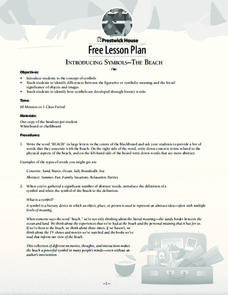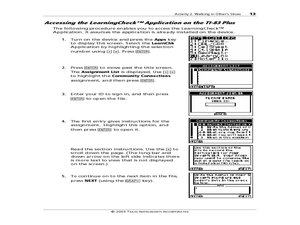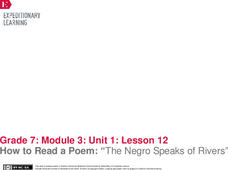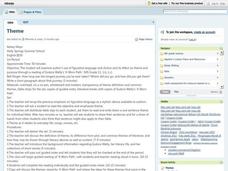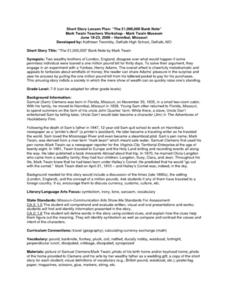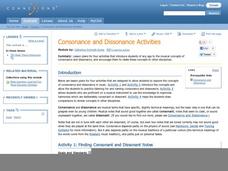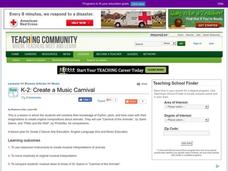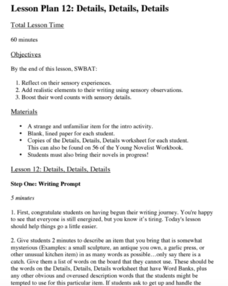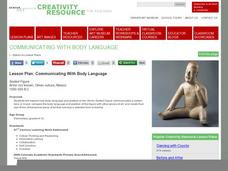Premier Literacy
Point of View
Incorporate technology into a literature lesson with an innovative language arts lesson. Middle schoolers read an electronic version of original stories or fairy tales, and after determining the point of view, rewrite the tale from...
Curated OER
The Outsiders
Tenth graders complete a variety of activities related to the first two chapters of the book The Outsiders. They define metaphor, simile, idiom, and hyperbole, and take a vocabulary pre-quiz. In small groups, they write a character...
Prestwick House
Introducing Symbols–The Beach
Looking for a way to introduce class members to the concept of symbolism and multiple levels of meaning? Readers examine two different passages about the beach and consider how the writers use concrete objects, and places to...
Curated OER
Using Drama to Examine Communities: Walking in Others' Shoes
Encourage your readers to make connections between texts with this resource. After compiling notes for each text read (you choose the texts), groups craft skits in which major characters from each text meet. There is a rubric for the...
Literacy Design Collaborative
Elie Wiesel's Acceptance Speech Analysis
Elie Wiesel's Nobel Prize Acceptance speech provides young historians with an opportunity to demonstrate their ability to use evidence from the speech. They work together to analyze how Wiesel uses rhetorical devices and syntax to...
Curated OER
Putting it Together: Analyzing and Producing Persuasive Text
Young orators demonstrate what they have learned about persuasion and persuasive devices throughout the unit by analyzing a persuasive speech and then crafting their persuasive essays. Class members engage in a role-play exercise, use...
EngageNY
How to Read a Poem: “The Negro Speaks of Rivers”
Learners listen as a teacher models how to read a poem using The Negro Speaks of
Rivers. They use the How to Read a Poem anchor chart to help guide their thought process on how a poem requires different reading than other text. While...
California Department of Education
Call the Tune: Music in Literature
I am dancing to the music in my head. Scholars learn to listen for music in their heads as they read literature and poems. After they identify and analyze poetic devices that relate to music, they create their own musical poems.
Curated OER
Theme
High schoolers investigate the concept of theme and how it is used in literary works. They read a variety of texts looking for the theme in each of them. Students also differentiate between the plot and theme by using a correct...
Curated OER
Things Aren't Always What They Seem
Students use video and the Internet to make predictions, draw conclusions, determine conflict and point of view while reading a short story. In this short story analysis lesson, students watch a related video and complete a prediction...
Curated OER
Expressing Your Views to the Letter
Analyze the motivation, purpose, and value of letters to the editor by examining letters written in response to the violence at Columbine High School. For homework, middle and high schoolers write their own letters to the editor about an...
Curated OER
"Take my Advice": Poems with a Voice
Discuss the meaning of the phrase tone of voice with the class. They respond to a variety of scenarios where a particular tone would be prevalent. They then read "Mother to Son" without knowing the title and answer some questions about...
Curated OER
"The 1,000,000 Pound Bank Note" by Mark Twain
Compare real events from Mark Twain's life to events in the story. Middle school readers identify point-of-view, its purpose, and its reliability by citing two examples. They describe the tone of the story using four examples and...
Curated OER
Hot, Hot, Hot, Cold
Learners dance the image of falling snow. They move, swing, fall, and rise to music working to depict snow falling, the sun, and high/low movements. This is a well-thought out lesson that aids them in seeing movement as a form of...
Curated OER
Creating Scrolls Based on the Illustrated Tale of Genji
Now these are learning activities full of fun, art, and cultural exploration. Kids consider the art of storytelling through comic book images. They then look at the Tale of Genji as it was written in the 11th century. They discuss...
Curated OER
Consonance and Dissonance Activities
Hone those musical ears to identify consonance and dissonance in music being played live or on a recording. Learners will work through four activities where they will listen to consonant and dissonant notes being played first by the...
Curated OER
Lesson: Paul Chan: Alternumeric Fonts
Learning to analyze language, symbols, and codes is part of becoming a deep and critical thinker. Young analysts consider their ability to see hidden messages as they analyze the work of Paul Chan. There are two fully developed...
Curated OER
Revive, Contemplate, Integrate
Students recognize flags as a symbol through writing and imagery. For this artifact lesson, students investigate Tibetan prayer flags and their significance. Students create personal prayer flags and write about their life experience of...
Curated OER
Story Telling through Photography
Use this writing and photography lesson plan in your descriptive writing unit. Elementary and middle schoolers write and create a story line incorporating photos from Inspiration or their own personal photos. They experiment with...
Curated OER
Create a Music Carnival
This outstanding lesson plan will encourage your students to combine their knowledge of rhythm, pitch, tone and color with their imaginations to create original compositions about animals. They create a music carnival to "Peter and the...
Curated OER
Seeing the Image in Imagery: A Lesson Plan Using Film
In our increasingly visual society, it is often difficult for some readers to create a mental picture of a picture created only with words. An image-rich text like F. Scott Fitzgerald's The Great Gatsby can therefore, present a real...
Curated OER
Details, Details, Details
Writing can become one-dimensional if authors don't involve all their senses. First, scholars observe a strange object which, ideally, they can touch and even smell. Without using certain words (you can create a list or have the class...
Curated OER
Lesson Plan: Communicating With Body Language
The Olmec were an ancient people native to Mexico who lived from 1000-500 BC. Young artists examine the Olmec piece Seated Figure to analyze the use of body language to communicate a tone or feeling. They then use clay or play-dough...
Curated OER
Lesson: Emphasis on Exaggeration
His ears, head, and designs are all an exaggerated form of art. Learners examine a South American sculpture in terms of how exaggeration was used to convey meaning. They then work through the design process as they create similarly...
Other popular searches
- Teaching Literary Devices
- Literary Devices and Terms
- Literary Devices & Quotes
- Common Literary Devices
- Literary Devices and Reading
- Introducing Literary Devices
- Literary Devices Irony
- Glossary of Literary Devices
- Literary Devices Inkheart
- Literary Devices Music
- Literary Device Flashback
- Ell Literary Device Activity


